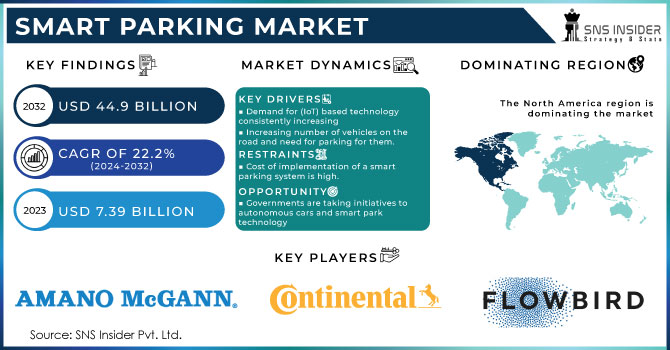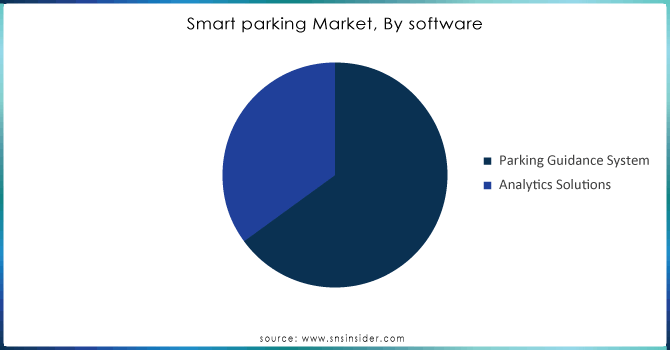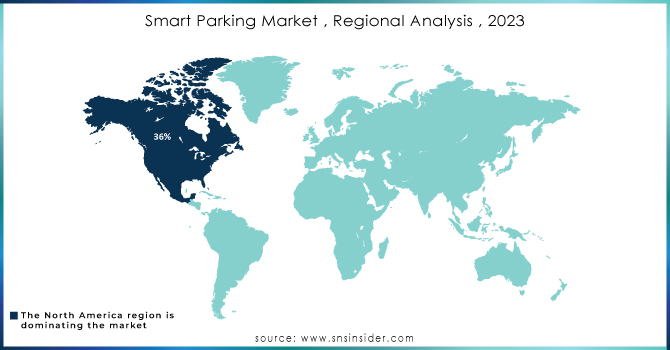Smart Parking Market Report Scope & Overview:

Get More Information on Smart Parking Market - Request Sample Report
Smart parking Market was worth USD 7.39 billion in 2023 and is predicted to be worth USD 44.9 billion by 2032, growing at a CAGR of 22.2% between 2024 and 2032.
The surging awareness of convenient and intelligent parking facilities, demand for smart parking systems OEMs and various applications. Smaller city trials have shown positive results. The rising demand for fully automated parking systems (APS), increasing traffic congestion, and the growing need of continuous advancements in machine-to-machine communication technology are some other major aspects pushing the growth of this industry. These systems can deliver huge benefits for city administrations, who struggle with how to manage their scatter parking infrastructure and drivers alike. The installation of smart parking meters, License Plate Recognition (LPR) cameras and Parking guidance systems has simplified the process which is associates with saving time as well as fuel consumption. Together with significant growth in global vehicle sales, these factors will fuel further market expansion. One study, by the International Parking & Mobility Institute, revealed that it took drivers in cities like Los Angeles 30% less time to find a parking spot thanks to smart solutions – helping us make better use of urban space. In San Francisco, for instance the city has introduced smart parking meters that uses sensors to monitor available parking spaces. Citing the San Francisco Municipal Transportation Agency (SFMTA), this system led to a 20% growth in parking turnover and a corresponding elimination of up to 30% of illegal spaces.
Urbanization is likely to exacerbate challenges like traffic congestion, but this can be remedied through smart city projects and campaigns. Smart city projects will be launched in countries such as India, the U.S., South Korea, China Australia Japan Germany and Brazil which are expected to further encourage the growth of smart parking system market. In October 2022, Indonesia's PT PP (Persero) Tbk signed a cooperation agreement with South Korea LG CNS to develop smart city projects in Nusantara. The adoption of wireless and digital payment technologies in automated parking solutions including advanced sensor, data analytics, M2M communication is projected to boost market growth.
Drivers
-
Demand for (IoT) based technology consistently increasing
-
Increasing number of vehicles on the road and global rise of traffic congestion.
-
Issue related to parking is consistently increasing across the world.
Urban mobility is significantly impacted by the continued global rise of traffic congestion. For example, INRIX recently released a study indicating U.S. drivers spent an average of 99 hours trapped in traffic jams 2022, slightly more than the 97 hours seen during 2021. In Europe, cities have also seen an increase in congestion the UK Department for Transport has noted that traffic levels rose 10% over last year on British roads. This causes congestion, as the more cars on a road there are they block and slow traffic down which hinders other vehicles from reaching their destinations in time thus also costs citizens money not only cost of fuel but fines taxes due to late delivery.
Smart Parking Systems solve this problem and provide real-time data on available parking spaces, thus reducing the time spent looking for a free space by drivers. In 2023, the International Parking & Mobility Institute estimated that smart parking systems could reduce overall traffic congestion by up to 40% through a report. By getting drivers to open spots faster and by reducing the time motorists waste driving around looking for parking, they also help traffic flow smooth which can minimize congestion costs. With the expanding urban spaces and increased traffic congestion, smart parking solutions definitely have a key role in managing the transportation system efficiently as they help improve mobility within large cities.
Opportunities
-
Continuously increasing smart cities.
-
Governments are taking initiatives to autonomous cars and smart park technology
Many automakers, including Tesla, Waymo, and Ford, have trialed a parking assistance feature in autonomous vehicles that displays parking spaces due to the constant advancement in technology. Technologies for controlling or parking vehicles using smartphones have been developed in several nations, including Canada, the United States, Germany, the United Kingdom, and others. The issue of congestion for smart parking is also addressed by frequent upgrades from software suppliers. Future profitable growth opportunities for the smart parking sector are predicted to result from ongoing infrastructure and technological advancements.
Segment Analysis
By software
Parking guidance systems segment held a revenue share of more than 69% in 2023,. These systems always available to provide guidance in terms of finding an finding vacant slots, provide parking guidelines, indicate the number of available spaces, and save time. Market participants improve on existing guidance systems, thereby securing a better foothold within the global smart parking market. For example, Quercus Technologies rolled out the SC Outdoor parking guidance system which drivers use to easily find available parking spaces on rooftops and outdoor areas using their BirdWatch parking management software.
During the forecast period analytics solutions is expected grow with a fastest CAGR of 24.8%. This growth is attributed to the capability of parking sensors installed on structures like light poles to collect detailed, reliable information about occupied and vacant spaces in real time. This data is transmitted to users through analytics solutions to ensure the security and safety of your parking sites especially during an emergency situation. Technology-driven companies are expected to rise which in turn will increase the efficiency of parking, booking and payment processes resulting in penetration by analytics solutions on a larger scale.

Need any customization research on Smart Parking Market - Enquiry Now
By Vertical
In 2023, commercial segment market with a revenue share of more than 59%. This is further anticipated to fuel growth of the smart parking segment owing increasing demand coming from corporate buildings, theatres, sport complexes and shopping malls. Moreover, the increase in flexible mobile payment services and easy-access to parking are expected to further boost up the growth of this segment over period.
Government segment is also expected to grow at a rapid pace with an estimated CAGR of 24.03% during forecast period of 2024-2032. This growth can be attributed to several smart city development projects, which have started deploying a large number of smart parking systems. The systems have a range of features, such as parking spot reservations reduction in overhead and then mobile payment. As part of their efforts to enhance user convenience and secure valuable government contracts, vendors are focusing on launching new mobile apps with innovative features. This is a major factor that will surge the growth of government application segment by 2032.
Regional analysis
North America was the largest market for smart parking, with over 36% share in global revenue recorded during 2023. The market is expected to grow in the coming years as number of vehicles are increasing in region and will continue fuelling demand for vehicle leasing over forecast period by 2032. Growing traffic congestion in North America has launched a multitude of public-private partnerships to bring smart parking solutions and technologies to cities. Another approach is via the governments, by engaging smart parking service providers to offer some of their safe and legal places for both private as well as commercial vehicles. Besides, the growing implementation of smart city initiatives is also contributing to surge in adoption of smart parking systems across the region. The results of a pilot in Boston revealed this smart parking systems could lower vehicle emissions by allowing drivers to spend less time idling as they search for parking. A pilot project shed the light on a 10% decrease in CO2 emissions in streets with smart parking technology whereas those without it.
Asia Pacific region is expected to grow at a significant CAGR of 24.9% over the forecast period. The growth is driven by the growing interest of regional governments in better management of parking, reduced air pollution and traffic congestion. Higher presence of global market players in the region and influx of start-ups are evident across this geographical expanse, which projected to drive growth. The likes of Indian smart parking solution provider ParkMate has secured funding from the Evolvex global accelerator program to improve its offering in September 2022.

Key Players
The major players are Amano McGann, Inc., Continental AG, Dongyang Menics Co., Ltd, IEM SA, IPS Group Inc., Klaus Multiparking Systems, Robert Bosch GmbH, Smart Parking Limited, Flowbird, Swarco AG, Urbiotica, SKIDATA AG, and others
Recent Development
Robert Bosch GmbH inked a deal with APCOA in January 2023 to provide Automated Valet Parking Technology in Parking Garages throughout Germany. Both firms intended to prepare up to four parking spaces per garage for automated valet parking.
Amano McGann, Inc. has engaged in cooperation with Soldier Field in Chicago to deliver New Parking Technology in October 2022. This system provides decreased maintenance costs, continuous upgrades, and simple Quick-Scan Onboarding.
| Report Attributes | Details |
| Market Size in 2023 | US$ 7.39 Bn |
| Market Size by 2032 | US$ 44.9 Bn |
| CAGR | CAGR of 22.2% From 2024 to 2032 |
| Base Year | 2023 |
| Forecast Period | 2024-2032 |
| Historical Data | 2020-2022 |
| Report Scope & Coverage | Market Size, Segments Analysis, Competitive Landscape, Regional Analysis, DROC & SWOT Analysis, Forecast Outlook |
| Key Segments | • By Component (Parking Sensors, Steering Angle Sensors, Electronic Control Unit (ECU), Display Unit) • By Software (Parking Guidance System, Analytics Solutions) • By Solution (Security and Surveillance, Parking Reservation Management, Valet Parking Management, License Plate Recognition) • By Sensor Technology (Ultrasonic Sensor, Radar Sensor, Image Sensor) • By Vertical (Government, Commercial) |
| Regional Analysis/Coverage | North America (US, Canada, Mexico), Europe (Eastern Europe [Poland, Romania, Hungary, Turkey, Rest of Eastern Europe] Western Europe] Germany, France, UK, Italy, Spain, Netherlands, Switzerland, Austria, Rest of Western Europe]). Asia Pacific (China, India, Japan, South Korea, Vietnam, Singapore, Australia, Rest of Asia Pacific), Middle East & Africa (Middle East [UAE, Egypt, Saudi Arabia, Qatar, Rest of Middle East], Africa [Nigeria, South Africa, Rest of Africa], Latin America (Brazil, Argentina, Colombia Rest of Latin America) |
| Company Profiles | Amano McGann, Inc., Continental AG, Dongyang Menics Co., Ltd, IEM SA, IPS Group Inc., Klaus Multiparking Systems, Robert Bosch GmbH, Smart Parking Limited, Flowbird, Swarco AG, Urbiotica, SKIDATA AG |
| Key Drivers | • Demand for (IoT) based technology consistently increasing • Increasing number of vehicles on the road and need for parking for them. • Issue related to parking is consistently increasing across the world. |
| Market Restraints | • Cost of implementation of a smart parking system is high. • Increasing the price of vehicles. |

